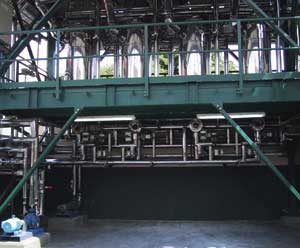Catalyzing Future Fuels




September 16, 2008
BY Jerry W. Kram
One cannot spend much time in the biofuels industry without becoming familiar with the jargon of the enzyme industry-amylases, cellulases and a host of others. However, these powerful protein catalysts have had little impact on the biodiesel industry. There are enzymes used for degumming vegetable oil, but none to catalyze the biodiesel process itself. Producers are forced to continue using alkaline catalysts such as potassium hydroxide or sodium methoxide to promote the basic transesterification reaction.
Danish company Novozymes wants to bring its expertise to bear on the biodiesel industry, says Steffen Ernst, Novozymes' director of research and development. The company is launching a 3½-year research project with two Danish universities to perfect an enzyme-catalyzed biodiesel production system. He says such a system would be a more sustainable option for biodiesel producers. "By sustainable we mean that producers could have a better carbon dioxide balance and would be less dependent on high-value agricultural products as feedstocks," he says. "That is not so easy with the current technology and we think the enzymatic technology has advantages to offer."
Novozymes will lead the $6 million research project. The project is being financed in part by a $3 million grant through the Danish National Advanced Technology Foundation and will be a joint effort among Novozymes, the Danish Technical University, Aarhus University and Emmelev Biodiesel. "Our vision is to enable a second-generation biodiesel technology with a documented, solid sustainability profile," Ernst says. "That is the reason for entering into this project. Also, this is a technology platform that has been demonstrated in principal but the actual development of the process will be the work that is going on now."
A New Approach
An enzyme-based biodiesel plant will have several advantages over a plant using alkaline catalysts, Ernst says. The enzyme-catalyzed reaction should proceed at a much lower temperature, saving energy which means both lower expenses and less carbon dioxide produced. Also, transesterification with alkaline catalysts requires an excess of methanol to ensure that all the fatty acids in the feedstock are reacted into biodiesel. The excess methanol has to be separated and purified before being reused. "This reaction will need much less of the alcohol than what is being used today," Ernst says.
The process will also allow direct conversion of free fatty acids (FFAs) into biodiesel. FFAs combine with alkaline catalysts to form soaps that not only require a washing step to be separated from the finished biodiesel, but they also inhibit the transesterification reaction. Converting the FFAs directly into biodiesel will allow the producers to use lower cost feedstocks such as yellow grease or alternatives such as algae oil without costly pretreatment. "From a chemical point of view, those are the main differences in the process," Ernst says. "I think today you are also seeing more and more people looking to alternative feedstocks to help reduce costs and comply with future requirements for sustainability."
A further advantage is that the enzymatic process can also produce ethyl esters of fatty acids. Ethanol can be used with an alkaline catalyst, but the reaction isn't as efficient and it is more difficult to remove water from the ethanol to regenerate it for reuse. But that isn't the case with the enzymatic process. In fact, Ernst says, using ethanol has some production advantages over methanol. "The enzymes actually work better with ethanol," he says. "You don't have the recycling problem because you are working at the stoichiometric level of ethanol, that is, you use almost exactly the amount of ethanol you need for the amount of oil you have instead of a large excess."
Ethyl esters can have a lower carbon footprint than methyl esters because most methanol is made from methane extracted from natural gas. As cellulosic ethanol becomes available, the carbon footprint of ethyl ester biodiesel should be even more favorable. "If you are looking toward meeting a certain sustainability criteria, if you use a 'green' ethanol you will meet that criteria quicker than when using methanol," Ernst says.
The reactor would be a departure from the traditional biodiesel plant design. The proposed design would use an enzyme immobilized as part of a solid-state catalyst. The reaction uses an enzyme called lipase which converts triglycerides into methyl esters in a single step. One of the questions the project will examine is whether a combination of lipases will have advantages over using a single enzyme. "The reaction for making biodiesel with enzymes has been known for some time now, but it has not been used for what you might call the first-generation biodiesel production technology, mainly for cost reasons," he says.
Lipases are used in many industries, including for processing vegetable oil and in laundry detergents. Novozymes is a major enzyme supplier to these industries. While the company has a great deal of experience with lipase enzymes, using them to produce biodiesel presents unique challenges. "We have a very good basis with the lipases we sell in other industries," Ernst says. "It is not certain that we can directly translate those uses using the same form of the enzyme. So we may be working on immobilizing the enzyme in a different way to make it more suited for this application. But we have a very good platform of the lipases we sell elsewhere, so we have a good starting point to be secure that we can move to market quickly."
Addressing Challenges
The technical challenges for the researchers will be to create an enzyme that can convert oils into biodiesel at a high rate, while being durable enough to create a robust, long-lasting catalyst that will work with less-than-ideal feedstocks. Solving those challenges will involve looking for new lipases and improving the process for incorporating the enzyme into a solid catalyst. "It will take both," Ernst says. "It will also require designing the process as it is carried out-what will the reactor configuration be, how will you add the reactants, how are you going to separate the products? That is part of what the university contributions will be in the collaboration."
Aarhus University will be in charge of enzyme kinetic studies and the investigation of methods for analysis, which will be used during the production process. The Danish Technical University will provide chemical engineers to design reactors and the operation parameters, and experts to conduct life-cycle assessments of production. Emmelev Biodiesel will contribute process know-how to the development project. Novozymes will work to make cost-effective enzymes for the biodiesel production process. "We think that with this grant we can meet both goals, making the enzyme cost competitive and demonstrating that the product will have a lower environmental impact," Ernst says.
The barriers to the enzymatic production of biodiesel are not primarily technical but economic, Ernst says. A major goal of the research project is to reduce the cost of the enzymes to the point where it is a feasible alternative to using alkaline catalysts. "The enzyme technology has developed greatly since the introduction of the biodiesel process," he explains. "We have good reason to believe, and this is validated by the scientific literature, that the efficiency of the enzyme process has become much better in recent years."
Shrinking Footprint
One of the reasons Novozymes is spearheading this effort is the company's belief that there is going to be a shift in the biofuels market to alternatives that have an even lower carbon footprint. Ernst says forthcoming greenhouse gas and life-cycle analysis regulations in Europe will create a higher demand for fuels with the lowest possible net carbon emissions. "We think the market will shift to biodiesel using a more sustainable process," he says. "We see that being part of the legislation in Britain now and also in the European Union. The legislative forces are pushing to introduce some criteria to measure the sustainability of the biodiesel process. We think this will lead to the need for a different way of making biodiesel."
When asked if this effort could be compared with the efforts to create enzymes to produce ethanol from cellulosic feedstocks, Ernst says this project was more of an expansion of an existing process than the creation of a new production platform. "Making second-generation ethanol also will include moving biomass materials to facilities to be processed," he says. "In the oils area, this is to a fair degree already happening. I would tend to say this will not be nearly as big a task as cellulosic ethanol."
While the biodiesel industry is presently experiencing some doldrums due to limited and expensive feedstock supplies, Novozymes is taking a long-term view toward the industry. "It is very difficult to see where the biodiesel industry is moving," Ernst says. "We believe we have a long-term perspective of having a major impact. But there are many different technologies being offered for biodiesel production and many different regions with their own political, technical and commercial agendas. The market is mixed right now and it is hard to see that changing in the short term. So the potential is there to have a big impact, but in time."
Jerry W. Kram is a Biodiesel Magazine staff writer. Reach him at jkram@bbiinternational.com or (701) 738-4920.
Danish company Novozymes wants to bring its expertise to bear on the biodiesel industry, says Steffen Ernst, Novozymes' director of research and development. The company is launching a 3½-year research project with two Danish universities to perfect an enzyme-catalyzed biodiesel production system. He says such a system would be a more sustainable option for biodiesel producers. "By sustainable we mean that producers could have a better carbon dioxide balance and would be less dependent on high-value agricultural products as feedstocks," he says. "That is not so easy with the current technology and we think the enzymatic technology has advantages to offer."
Novozymes will lead the $6 million research project. The project is being financed in part by a $3 million grant through the Danish National Advanced Technology Foundation and will be a joint effort among Novozymes, the Danish Technical University, Aarhus University and Emmelev Biodiesel. "Our vision is to enable a second-generation biodiesel technology with a documented, solid sustainability profile," Ernst says. "That is the reason for entering into this project. Also, this is a technology platform that has been demonstrated in principal but the actual development of the process will be the work that is going on now."
A New Approach
An enzyme-based biodiesel plant will have several advantages over a plant using alkaline catalysts, Ernst says. The enzyme-catalyzed reaction should proceed at a much lower temperature, saving energy which means both lower expenses and less carbon dioxide produced. Also, transesterification with alkaline catalysts requires an excess of methanol to ensure that all the fatty acids in the feedstock are reacted into biodiesel. The excess methanol has to be separated and purified before being reused. "This reaction will need much less of the alcohol than what is being used today," Ernst says.
The process will also allow direct conversion of free fatty acids (FFAs) into biodiesel. FFAs combine with alkaline catalysts to form soaps that not only require a washing step to be separated from the finished biodiesel, but they also inhibit the transesterification reaction. Converting the FFAs directly into biodiesel will allow the producers to use lower cost feedstocks such as yellow grease or alternatives such as algae oil without costly pretreatment. "From a chemical point of view, those are the main differences in the process," Ernst says. "I think today you are also seeing more and more people looking to alternative feedstocks to help reduce costs and comply with future requirements for sustainability."
A further advantage is that the enzymatic process can also produce ethyl esters of fatty acids. Ethanol can be used with an alkaline catalyst, but the reaction isn't as efficient and it is more difficult to remove water from the ethanol to regenerate it for reuse. But that isn't the case with the enzymatic process. In fact, Ernst says, using ethanol has some production advantages over methanol. "The enzymes actually work better with ethanol," he says. "You don't have the recycling problem because you are working at the stoichiometric level of ethanol, that is, you use almost exactly the amount of ethanol you need for the amount of oil you have instead of a large excess."
Ethyl esters can have a lower carbon footprint than methyl esters because most methanol is made from methane extracted from natural gas. As cellulosic ethanol becomes available, the carbon footprint of ethyl ester biodiesel should be even more favorable. "If you are looking toward meeting a certain sustainability criteria, if you use a 'green' ethanol you will meet that criteria quicker than when using methanol," Ernst says.
The reactor would be a departure from the traditional biodiesel plant design. The proposed design would use an enzyme immobilized as part of a solid-state catalyst. The reaction uses an enzyme called lipase which converts triglycerides into methyl esters in a single step. One of the questions the project will examine is whether a combination of lipases will have advantages over using a single enzyme. "The reaction for making biodiesel with enzymes has been known for some time now, but it has not been used for what you might call the first-generation biodiesel production technology, mainly for cost reasons," he says.
Lipases are used in many industries, including for processing vegetable oil and in laundry detergents. Novozymes is a major enzyme supplier to these industries. While the company has a great deal of experience with lipase enzymes, using them to produce biodiesel presents unique challenges. "We have a very good basis with the lipases we sell in other industries," Ernst says. "It is not certain that we can directly translate those uses using the same form of the enzyme. So we may be working on immobilizing the enzyme in a different way to make it more suited for this application. But we have a very good platform of the lipases we sell elsewhere, so we have a good starting point to be secure that we can move to market quickly."
Addressing Challenges
The technical challenges for the researchers will be to create an enzyme that can convert oils into biodiesel at a high rate, while being durable enough to create a robust, long-lasting catalyst that will work with less-than-ideal feedstocks. Solving those challenges will involve looking for new lipases and improving the process for incorporating the enzyme into a solid catalyst. "It will take both," Ernst says. "It will also require designing the process as it is carried out-what will the reactor configuration be, how will you add the reactants, how are you going to separate the products? That is part of what the university contributions will be in the collaboration."
Aarhus University will be in charge of enzyme kinetic studies and the investigation of methods for analysis, which will be used during the production process. The Danish Technical University will provide chemical engineers to design reactors and the operation parameters, and experts to conduct life-cycle assessments of production. Emmelev Biodiesel will contribute process know-how to the development project. Novozymes will work to make cost-effective enzymes for the biodiesel production process. "We think that with this grant we can meet both goals, making the enzyme cost competitive and demonstrating that the product will have a lower environmental impact," Ernst says.
The barriers to the enzymatic production of biodiesel are not primarily technical but economic, Ernst says. A major goal of the research project is to reduce the cost of the enzymes to the point where it is a feasible alternative to using alkaline catalysts. "The enzyme technology has developed greatly since the introduction of the biodiesel process," he explains. "We have good reason to believe, and this is validated by the scientific literature, that the efficiency of the enzyme process has become much better in recent years."
Shrinking Footprint
One of the reasons Novozymes is spearheading this effort is the company's belief that there is going to be a shift in the biofuels market to alternatives that have an even lower carbon footprint. Ernst says forthcoming greenhouse gas and life-cycle analysis regulations in Europe will create a higher demand for fuels with the lowest possible net carbon emissions. "We think the market will shift to biodiesel using a more sustainable process," he says. "We see that being part of the legislation in Britain now and also in the European Union. The legislative forces are pushing to introduce some criteria to measure the sustainability of the biodiesel process. We think this will lead to the need for a different way of making biodiesel."
When asked if this effort could be compared with the efforts to create enzymes to produce ethanol from cellulosic feedstocks, Ernst says this project was more of an expansion of an existing process than the creation of a new production platform. "Making second-generation ethanol also will include moving biomass materials to facilities to be processed," he says. "In the oils area, this is to a fair degree already happening. I would tend to say this will not be nearly as big a task as cellulosic ethanol."
While the biodiesel industry is presently experiencing some doldrums due to limited and expensive feedstock supplies, Novozymes is taking a long-term view toward the industry. "It is very difficult to see where the biodiesel industry is moving," Ernst says. "We believe we have a long-term perspective of having a major impact. But there are many different technologies being offered for biodiesel production and many different regions with their own political, technical and commercial agendas. The market is mixed right now and it is hard to see that changing in the short term. So the potential is there to have a big impact, but in time."
Jerry W. Kram is a Biodiesel Magazine staff writer. Reach him at jkram@bbiinternational.com or (701) 738-4920.
Advertisement
Advertisement
Advertisement
Advertisement
Upcoming Events





